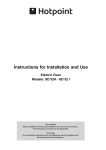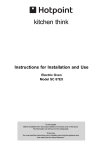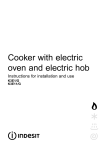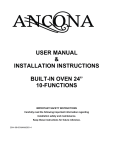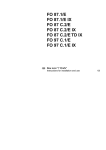Download Merloni FB 51 GB Owner`s manual
Transcript
FB 51 GB FB 51 IX GB Multifunction Oven Instructions for installation and use 2 Congratulations on choosing an Ariston appliance, which you will find is dependable and easy to use. We recommend that you read the instructions in this owner’s manual carefully before use for the best performance and to extend the life of your appliance, as it will provide you with all the instructions you require to ensure its safe installation, use and maintenance. Always keep this owner’s manual close to hand since you may need to refer to it in the future. Thank you. Close-up view A. B. C. D. E. Control Panel Cooking mode selection knob Cooking temperature selection knob Timer knob (only available on certain models) Oven indicator light (only available on certain models) - When lit, it indicates the ovens is heating up to the temperature set. F. Dripping Pan or Baking Sheet G. Oven Rack H. Guides for sliding the racks or dripping pan in and out A H G F E B D C 2 How to use your oven This multi-function oven combines the advantages of traditional convection ovens with those of the more modern fan assisted models in a single appliance. It is an extremely versatile appliance that allows you to choose easily and safely between 5 different cooking modes. The various features offered by the oven are selected by means of selector knob “B” and thermostat “C” situated on the control panel. the section entitled: “Cooking On More Than One Rack”. This fan assisted mode is particularly recommended for dishes requiring a gratin finish or for those requiring considerably prolonged cooking times, such as for example: lasagne, pasta bakes, roast chicken and potatoes, etc… Moreover, the excellent heat distribution makes it possible to use lower temperatures when cooking roasts. This results in less loss of juices, meat which is more tender and a decrease in the loss of weight for the roast. The fan assisted mode is especially suited for cooking fish, which can be prepared with the addition of a limited amount of condiments, thus maintaining their flavour and appearance. Desserts: the fan assisted mode is also perfect for baking leavened cakes. Moreover, this mode can also be used to thaw quickly white or red meat and bread by setting the temperature to 80 °C. To thaw more delicate foods, set the thermostat to 60°C or use only the cold air circulation feature by setting the thermostat to 0°C. Notice: The first time you use your appliance, we recommend that you set the thermostat to the highest setting and leave the oven on for about half an hour with nothing in it, with the oven door shut. Then, open the oven door and let the room air. The odour that is often detected during this initial use is due to the evaporation of substances used to protect the oven during storage and until it is installed. Notice: Place the dripping pan provided on the bottom shelf of the oven to prevent any sauce and/or grease from dripping onto the bottom of the oven only when grilling food or when using the rotisserie (only available on certain models). For all other types of cooking, never use the bottom shelf and never place anything on the bottom of the oven when it is in operation because this could damage the enamel. Always place your cookware (dishes, aluminium foil, etc. etc.) on the grid provided with the appliance inserted especially along the oven guides “Top” oven c Position of thermostat knob “C”: Between 60°C and Max. The top heating element comes on. This mode can be used to brown food at the end of cooking. Grill d Position of thermostat knob “C”: Max The top central heating element comes on. The extremely high and direct temperature of the grill makes it possible to brown the surface of meats and roasts while locking in the juices to keep them tender. The grill is also highly recommended for dishes that require a high temperature on the surface: beef steaks, veal, rib steak, filets, hamburgers etc... Some grilling examples are included in the “Practical Cooking Advice” paragraph. Convection Mode a Position of thermostat knob “C”: between 60°C and Max. On this setting, the top and bottom heating elements come on. This is the classic, traditional type of oven which has been perfected, with exceptional heat distribution and reduced energy consumption. The convection oven is still unequalled when it comes to cooking dishes made up of several ingredients, e.g. cabbage with ribs, Spanish style cod, Ancona style stockfish, tender veal strips with rice, etc. Excellent results are achieved when preparing veal or beef-based dishes as well (braised meats, stew, goulash, wild game, ham etc.) which need to cook slowly and require basting or the addition of liquid. It nonetheless remains the best system for baking cakes as well as fruit and cooking using covered casserole dishes for oven baking. When cooking in convection mode, only use one dripping pan or cooking rack at a time, otherwise the heat distribution will be uneven. Using the different rack heights available, you can balance the amount of heat between the top and the bottom of the oven. Select from among the various rack heights based on whether the dish needs more or less heat from the top. Fan Assisted Grill e Position of thermostat knob “C”: between 60°C and 200°C. The top central heating element and the fan come on. This combination of features increases the effectiveness of the unidirectional thermal radiation of the heating elements through forced circulation of the air throughout the oven. This helps prevent food from burning on the surface, allowing the heat to penetrate right into the food. Excellent results are achieved with kebabs made with meats and vegetables, sausages, ribs, lamb chops, chicken in a spicy sauce, quail, pork chops, etc. This mode is also ideal for cooking fish steaks, like swordfish, tuna, grouper, stuffed cuttlefish etc. Timer (D) (only available on certain models) To use the timer, the buzzer “D” must be wound up by turning the knob one full turn clockwise 4; then turn it back 5 to the desired time so that the number of minutes on the knob matches the reference mark on the panel. Fan Assisted Mode b Position of thermostat knob “C”: Between 60°C and Max. The heating elements, as well as the fan, will come on. Since the heat remains constant and uniform throughout the oven, the air cooks and browns food uniformly over its entire surface. With this mode, you can also cook various dishes at the same time, as long as their respective cooking temperatures are the same. A maximum of 2 racks can be used at the same time, following the instructions in 3 The oven light Set knob “B” to the 8 symbol to turn it on. It lights the oven and stays on when any of the electrical heating elements in the oven come on. Cooling ventilation In order to cool down the temperature of their exterior, some models are equipped with a cooling fan that comes on by turning the selector knob “B”. During cooking, the fan is always on and a normal flow of air can be heard exiting between the oven door and the control panel. Note: when cooking is done, the fan stays on until the oven cools down sufficiently. How to Keep Your Oven in Shape How to remove the oven door For a more thorough clean, you can remove the oven door. Proceed as follows: • open the door fully; • lift up and turn the small levers situated on the two hinges; • grip the door on the two external sides, shut it slowly but not completely; • pull the door towards you, pulling it out of its seat; Reassemble the door by following the above procedures backwards. Before cleaning your oven, or performing maintenance, disconnect it from the power supply. To extend the life of your oven, it must be cleaned frequently, keeping in mind that: • the enamelled or stainless steel parts should be washed with lukewarm water without using any abrasive powders or corrosive substances which could ruin them; Stainless steel could get stained. If these stains are difficult to remove, use special products available on the market. After cleaning, it is advisable to rinse thoroughly and dry. • the inside of the oven should preferably be cleaned immediately after use, when it is still warm, with hot water and soap; the soap should be rinsed away and the interior dried thoroughly. Avoid using abrasive detergents (for example cleaning powders, etc…) and abrasive sponges for dishes or acids (such as limescale-remover, etc…) as these could damage the enamel. If the grease spots and dirt are particularly tough to remove, use a special product for oven cleaning, following the instructions provided on the packet. • if you use your oven for an extended period of time, condensation may form. Dry it using a soft cloth. • there is a rubber seal surrounding the oven opening which guarantees its perfect functioning. Check the condition of this seal on a regular basis. If necessary, clean it and avoid using abrasive products or objects to do so. Should it become damaged, please contact your nearest After-sales Service Centre. We recommend you avoid using the oven until it has been repaired. • never line the oven bottom with aluminium foil, as the consequent accumulation of heat could compromise the cooking and even damage the enamel. • clean the glass door using non-abrasive products or sponges and dry it with a soft cloth. 1 2 3 Replacing the Oven Lamp • Disconnect the oven from the power supply by means of the omnipolar switch used to connect the appliance to the electrical mains; or unplug the appliance if the plug is accessible; • Remove the glass cover of the lamp-holder; • Remove the lamp and replace with a lamp resistant to high temperatures (300°C) with the following characteristics: - Voltage: 230/240 V - Wattage 25W - Type E14 • Replace the glass cover and reconnect the oven to the mains power supply. 4 Practical Cooking Advice When using this mode, place the grid on the 2nd or 3rd oven rack from the bottom (see cooking table) then, to prevent fat and grease from dripping onto the bottom of the oven and thus smoke from forming, place a drippingpan on the 1st rack from the bottom. Important: always use the “fan assisted grill” with the oven door shut. This will allow you both to obtain excellent results and to save on energy (approximately 10%). When using this mode, we advise you to set the thermostat to 200°C, as it is the most efficient way to use the grill, which is based on the use of infrared rays. However, this does not mean you cannot use lower temperatures, simply by adjusting the thermostat knob to the desired temperature. Therefore the best results when using the grill modes are obtained by placing the grid on the lower racks (see cooking table) then, to prevent fat and grease from dripping onto the bottom of the oven and smoke from forming, place a dripping-pan on the 1st oven rack from the bottom. The oven offers a wide range of alternatives which allow you to cook any type of food in the best possible way. With time you will learn to make the best use of this versatile cooking appliance and the following directions are only a guideline which may be varied according to your own personal experience. Preheating If the oven must be preheated (this is generally the case when cooking leavened foods), the “fan assisted” mode b can be used to reach the desired temperature as quickly as possible in order to save on energy. Once the food has been placed in the oven, the most appropriate cooking mode can then be selected. Cooking on More Than One Rack If you have to cook on more than one rack at the same time, use only the “fan assisted mode” b which is the only one that is appropriate for this type of cooking. • • • • The oven is fitted with 5 racks. During fan assisted cooking, use two of the three central racks; the lowest and highest racks receive the hot air directly and therefore delicate foodstuffs could be burnt on these racks. As a general rule, use the 2nd and 4th rack from the bottom, placing the foodstuffs that require greater heat on the 2nd rack from the bottom. For example, when cooking meat roasts together with other food, place the roast on the 2nd rack from the bottom and the more delicate food on the 4th rack from the bottom. When cooking foodstuffs that require differing times and temperatures, set a temperature that is somewhere between the two temperatures required, place the more delicate food on the 4th rack from the bottom and take the food requiring less time out of the oven first. Use the dripping pan on the lower rack and the grid on the upper; Baking Cakes When baking cakes, always place them in a preheated oven. Make sure you wait until the oven has been preheated thoroughly (the red light “E” will turn off). Do not open the oven door during baking to prevent the cake from dropping. In general: Pastry is too dry Increase the temperature by 10°C and reduce the cooking time. Pastry dropped Use less liquid or lower the temperature by 10°C. Pastry is too dark on top Place it on a lower rack, lower the temperature, and increase the cooking time. Using the Grill This multi-function oven offers you 2 different grilling modes. Use the “grill” mode d, with the oven door ajar, placing the food under the centre of the grill (situated on the 3rd or 4th rack form the bottom) because only the central part of the top heating element is turned on. Use the bottom rack (1st from the bottom), placing the dripping pan provided to collect any sauce and/or grease and prevent the same from dripping onto the oven bottom. When using this mode, we recommend you set the thermostat to the highest setting. However, this does not mean you cannot use lower temperatures, simply by adjusting the thermostat knob to the desired temperature. Setting e “fan assisted grill”, only with the oven door shut, is extremely useful for grilling foods rapidly, as the distribution of heat makes it possible not only to brown the surface, but also to cook the bottom part. Moreover, it can also be used for browning foods at the end of the cooking process, such as adding that gratin finish to pasta bakes, for example. Cooked well on the inside but sticky on the outside Use less liquid, lower the temperature, and increase the cooking time. The pastry sticks to the pan Grease the pan well and sprinkle it with a dusting of flour or use greaseproof paper. I used more than one level (in the function "ventilated oven") and they are not all at the same cooking point Use a lower temperature setting. It is not necessary to remove the food from all the racks at the same time. 5 Cooking Fish and Meat When cooking white meat, fowl and fish, use temperature settings from 180 °C to 200 °C. For red meat that should be well done on the outside while tender and juicy in the inside, it is a good idea to start with a high temperature setting (200°C-220°C) for a short time, then turn the oven down afterwards. In general, the larger the roast, the lower the temperature setting. Place the meat on the centre of the grid and place the dripping pan beneath it to catch the fat. Make sure that the grid is inserted so that it is in the centre of the oven. If you would like to increase the amount of heat from below, use the low rack heights. For savoury roasts (especially duck and wild game), dress the meat with lard or bacon on the top. Cooking Pizza For best results when cooking pizza, use the “fan assisted “ b mode: • Preheat the oven for at least 10 minutes; • Use a light aluminium pizza pan, placing it on the grid supplied with the oven. If the dripping pan is used, this will extend the cooking time, making it difficult to get a crispy crust; • Do not open the oven door frequently while the pizza is cooking; • If the pizza has a lot of toppings (three of four), we recommend you add the mozzarella cheese on top halfway through the cooking process. • When cooking pizza on two racks, use the 2nd and 4th with a temperature of 220°C and place the pizzas in the oven after having preheated it for at least 10 minutes. 6 Selector knob Food to be cooked setting 1 Convection a 2 Fan assisted b 3 Top Oven c 4 Grill d 5 Fan assisted grill Weight (in kg) Cooking rack position from bottom Preheating time (minutes) Thermostat knob setting Cooking time (minutes) 1 1 1 1 3 3 3 3 3 15 15 15 15 15 200 200 200 180 180 65-75 70-75 70-80 15-20 30-35 Pizza (on 2 racks) Lasagne Lamb Roast chicken + potatoes Mackerel Plum-cake Cream puffs (on 2 racks) Biscuits (on 2 racks) Sponge cake (on 1 rack) Sponge cake (on 2 racks) Savoury pies 1 1 1 1 1 1 0.5 0.5 0.5 1.0 1.5 2-4 3 2 2-4 2 2 2-4 2-4 2 2-4 3 15 10 10 10 10 10 10 10 10 10 15 220 200 180 180 180 170 190 180 170 170 200 15-20 30-35 50-60 60-75 30-35 40-50 20-25 10-15 15-20 20-25 25-30 Browning food to perfect cooking - 3/4 15 220 - Soles and cuttlefish Squid and prawn kebabs Cod filet Grilled vegetables Veal steak Cutlets Hamburgers Mackerels Toasted sandwiches 1 1 1 1 1 1 1 1 n.° 4 4 4 4 3/4 4 4 4 4 4 5 5 5 5 5 5 5 5 5 Max Max Max Max Max Max Max Max Max 8-10 6-8 10 10-15 15-20 15-20 7-10 15-20 2-3 With rotisserie (where present) Veal on the spit Chicken on the spit Lamb on the spit 1.0 1.5 1.0 - 5 5 5 Max Max Max 80-90 70-80 70-80 Grilled chicken Cuttlefish 1.5 1.5 3 3 5 5 200 200 55-60 30-35 With rotisserie (where present) Veal on the spit Chicken on the spit Chicken (on the spit) + potatoes (roasted) Lamb on the spit 1.5 2.0 1.5 1.5 2 - 5 5 5 5 5 200 200 200 200 200 70-80 70-80 70-75 70-75 70-80 Duck Roast veal or beef Pork roast Biscuits (short pastry) Tarts e NB: cooking times are approximate and may vary according to personal taste. When cooking using the grill or fan assisted grill, the dripping pan must always be placed on the 1st oven rack from the bottom. 7 Safety Is A Good Habit To Get Into To maintain the efficiency and safety of this appliance, we recommend that you do the following: • only call the Service Centres authorised by the manufacturer • always use original spare parts • • • • This appliance is designed for non-professional, household use and its functions must not be changed. These instructions are only valid for the countries whose symbols appear on the manual and the serial number plate. The electrical system of this appliance can only be used safely when it is correctly connected to an efficient earthing system in compliance with current safety standards. When the appliance is in use, the heating elements and some parts of the oven door become extremely hot. Make sure you don’t touch them and keep children well away. Qualified personnel must be contacted in the following cases: - Installation (following the manufacturer’s instructions); - When in doubt about operating the appliance; - Replacing the electrical socket when it is not compatible with the appliance plug. Service Centres authorised by the manufacturer must be contacted in the following cases: - If in doubt about the soundness of the appliance after removing it from its packaging; - If the power supply cable has been damaged or needs to be replaced; - If the appliance breaks down or functions poorly; ask for original spare parts. The following items are potentially dangerous, and therefore appropriate measures must be taken to prevent children and the disabled from coming into contact with them: - Controls and the appliance in general; - Packaging (bags, polystyrene, nails, etc.); - The appliance itself, immediately after use of the oven or grill due to the heat generated; - The appliance itself, when no longer in use (potentially dangerous parts must be made safe). It is a good idea to do the following: - Only use the appliance to cook food and nothing else; - Check the soundness of the appliance after it has been unpacked; - Disconnect the appliance from the electrical mains if it is not functioning properly and before cleaning or performing maintenance; - When left unused, unplug the appliance form the electricity mains and turn off the gas tap (if foreseen); - Use oven gloves to place cookware in the oven or when removing it; - Always grip the oven door handle in the centre as the extremities of the same may be hot due to any hot air leaks; - Make sure the knobs are in the “•”/”o” position when the appliance is not in use. - Cut the power supply cable after disconnecting it from the mains when you decide not to use the appliance any longer. • The manufacturer may not be held responsible for any damage due to: incorrect installation, improper, incorrect and irrational use. Avoid the following: - Touching the appliance with wet parts of the body; - Using the appliance when barefoot; - Pulling on the appliance or the supply cable to unplug it from the electrical outlet; - Improper or dangerous operations; - Obstructing the ventilation or heat dissipation slots; - Allowing power supply cables of small appliances to come into contact with the hot parts of the appliance; - Exposing the appliance to atmospheric agents such as rain, or sunlight; - Using the oven for storage purposes; - Using flammable liquids near the appliance; - Using adapters, multiple sockets and/or extension leads; - Attempting to install or repair the appliance without the assistance of qualified personnel. 8 Instalation The appliance must be installed only by a qualified person in compliance with the instructions provided. The manufacturer declines all responsibility for improper installation which may harm persons and animals and damage property. Important: The power supply to the appliance must be cut off before any adjustments or maintenance work is done on it. The panels of the adjacent cabinets must be made of heatresistant material. In particular, cabinets with a veneer exterior must be assembled with glues which can withstand temperatures of up to 100 °C. In compliance with current safety standards, contact with the electrical parts of the oven must not be possible once it has been installed. All parts which ensure the safe operation of the appliance must be removable only with the aid of a tool. For the correct centring of your appliance, position the 4 tabs on the sides of the oven in correspondence with the 4 holes on the perimeter of the frame. In particular, if the cabinet side panel: • is 20 mm thick: the removable part of the tab must be removed (Fig. A); • is 18 mm thick: use the first groove, which is factoryset (Fig. B); • is 16 mm thick: use the second groove (Fig.C) 23 mm. Installation of Built-in Ovens In order to ensure that the built-in appliance functions properly, the cabinet containing it must be appropriate. The figure below gives the dimensions of the cut-out for installation under the counter or in a wall cabinet unit. m. 593 mm. 558 mm . 5 mm. 567 mm. 595 mm. 45 m 595 . mm 545 . mm . 24 mm Fig. A . 595 mm. mm 575-585 mm. 558 45 595 Fig. C To fasten the oven to the cabinet, open the door of the oven and attach it by inserting the 4 wooden screws into the 4 holes located on the perimeter of the frame. . mm 545 . mm . 24 Fig. B . mm . n mi 5 mm. 567 mm. 595 mm. 23 mm. m. 45 m . min mm In order to ensure adequate ventilation, the back panel of the cabinet unit must be removed. Installing the oven so that it rests on two strips of wood is preferable. If the oven rests on a continuous, flat surface, there must be an aperture of at least 45 x 560 mm. . 560 mm 45 m m. 9 Electrical connection Ovens with a three-pole power supply cable are designed to operate with alternated current at the supply frequency and voltage indicated on the data plate (at the bottom of the oven dashboard). The earthing conductor of the cable is the yellow-green conductor. Two types of connection are provided: Connection n° 2 Disposing of the plug. WARNING: THIS APPLIANCE MUST BE EARTHED. Ensure that before disposing of the plug itself, you make the pins unusable so that it cannot be accidentally inserted into a socket. Instructions for connecting cable to an alternative plug: Important: the wires in the mains lead are coloured in accordance with the following code: Green & Yellow -Earth Blue -Neutral Brown -Live If the colours of the wires in the mains lead do not correspond with the coloured markings identifying the terminals in your plug, proceed as follows. Connect Green & Yellow wire to terminal marked “E” or 6 or coloured Green or Green & Yellow. Connect Brown wire to terminal marked “L” or coloured Red. Connect Blue wire to terminal marked “N” or coloured Black. If a 13 amp plug (BS 1363) is used it must be fitted with a 13 amp fuse. A 15 amp plug must be protected by a 15 amp fuse, either in the plug or adaptor or at the distribution board.If you are in any doubt about the electrical supply to your machine, consult a qualified electrician before use. Connection n° 1 Connecting the power supply cable to the mains. Fit a normalized plug to the cable, which corresponds to the load indicated on the data plate; if the cooker is connected directly to the mains, an omnipolar circuitbreaker with a minimum opening of 3 mm between the contacts, suitable for the load indicated and complying with current directives, must be installed between the appliance and the mains (the earthing wire must not be interrupted by the circuit-breaker). The power supply cable must be positioned so that it does not exceed room temperature by 50°C at any point of its length. Before making the connection check that: • the circuit breakers or fuses of the home system can support appliance load (see data plate); • the power supply system has an efficient earthing connection which complies with the provisions of current regulations and the law; • there is easy access to the socket or the omnipolar circuit-breaker once the cooker has been installed. N.B.: do not use reducers, adapters or shunts as these could cause heating or burning. How to connect an alternative plug The wires in this mains lead are coloured in accordance with the following code: BLUE “NEUTRAL” (N) BROWN “LIVE” (L) GREEN AND YELLOW “EARTH” (E) GREEN & YELLOW BROWN BLUE 13 amp fuse CROSS-BAR CORD GRIP Disposing of the appliance When disposing of the appliance please remove the plug by cutting the mains cable as close as possible to the plug body and dispose of it as described above. The plug and socket must be easily accessible. 10 Technical Specifications Inner dimensions of the oven: Voltage and Frequency of Power Supply: 230-240V ~ 50/60Hz 2250-2400W Width 43.5 cm Depth 40 cm Height 32 cm 7 Inner Volume of the Oven: 56 litres Consumption (non fan assisted models): to reach 200°C: kWh 0,40 to maintain 200°C for an hour: kWh 0,65 total consumption: kWh 1,05 This appliance conforms with the following European Economic Community directives: - Consumption (fan assisted models): to reach 200°C: kWh 0,40 to maintain 200°C for an hour: kWh 0,95 total consumption: kWh 1,35 - 11 73/23/EEC of 19/02/73 (Low Voltage) and subsequent modifications; 89/336/EEC of 03/05/89 (Electromagnetic Compatibility) and subsequent modifications; 93/68/EEC of 22/07/93 and subsequent modifications. Nuovo Forno da incasso “Multifunzione” (Spec. GB) 04/02 - 195031598.01 Xerox Business Services - Docutech viale Aristide Merloni, 47 - 60044 Fabriano tel. 0732/6611 - telex 560196 - fax 0732/662954 www.Merloni.com
















